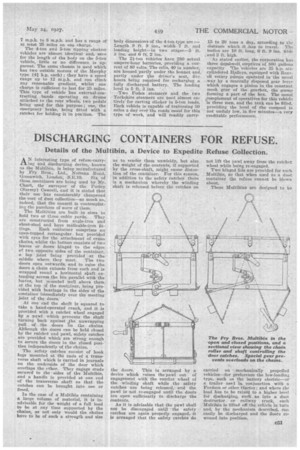A N interesting type of refuse-carrying and discharging device, known as
Page 109

If you've noticed an error in this article please click here to report it so we can fix it.
the Multibin, is being manufactured by Fry Bros., Ltd., Norman -Road,
Gteenivich, l4ondon, S.E.10. Six of these containers are being used by Mr. Chart, the surveyor of the Purley (Surrey) Council, and it is stated that their use has considerably cheapened the cost of dust collection—so much so, indeed, that the council is contemplating the purchase of more of them.
The Multibins are built in sizes to hold two or three cubic yards. They are constructed from angle-iron and sheet-steel and have malleable-iron fit tings. Each container comprises an open-topped rectangular box provided with eyes for the attachment of crane chains, whilst the bottom consists of two leaves or doors hinged to the edges 411 two opposite sides of the container, .
it lap joint being provided ".at the middle where they meet. The two doors open outwards, and to raise the doors It chain extends from each and is wrapped round a horizontal sliaft extending across the bin parallel, with the loaves, but mounted well above them at the top 7.if the container, being provided with beatings in the sides of the cmtainer immediately over the meeting joint of the doors..
At one end the shaft is squared to take a hand-operated crank, and it is provided with a ratchet wheel engaged by a pawl which prevents the shaft turning hack against the unwrapping pull of the doors en the chains. Although the doors can be held closed by the ratchet and pawl, safety catches are provided which are strotig enough to secure the doors in the closed posi tion independently of the chains. • The safety catches consist of hook lugs mounted at. the ends of a transverse shaft which is carried in journals on the underside of the door which overlaps the ether. They engage studs secured to the sides of the Multibin, and a handle is provided at one end of the transverse shaft so that the catches can be brought into use or freed.
In the case of a Multibin containing a large volume of material, it is inadvisable for the weight of a full load to be at any time supported by the chains, as not only would the chains have to be of such a strength and size
as to render them unwieldy, but also the weight of the contents, if supported by the cross-shaft, might cause distortion of the container. For this reason, in addition to the safety catches there is a mechanism whereby the winding shaft is released before the catches on the doors. This is arranged by a device which raises the pawl out of engagement with the ratchet wheel of the -winding shaft while the safety catches are being released, and the pawl is not re-engaged until the doors are open sufficiently to discharge the contents.
As it is advisable that the pawl shalt not be disengaged until the safety catches are again properly engaged, it is arranged that the safety catches do not lift the pawl away from the ratchet wheel while being re-engaged.
-Two hinged lids are provided for each Multibin, so that when used as a dust container the refuse cannot be blown about.
These Multibins are designed to be carried on mechanically propelled .vehicles—for preference the low-loading type, -such as the battery electric—or . a trailer used in conjunction with a Fordson or other tractor ; and where the load has to be raised to a higher level for, djscharging, such as into a dust destructor or railway truck, each Maltibin is lifted off the -vehicle in turn and, by the mechanism described, can easily be discharged and the doors rewound into position.




















































































































































































